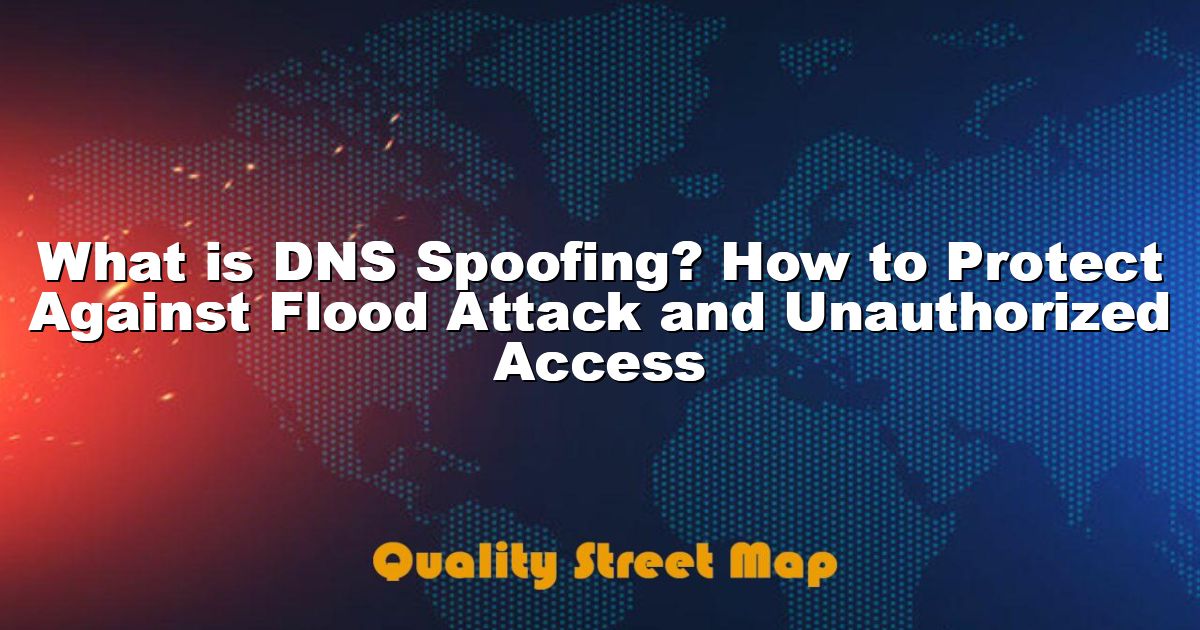What is DNS Spoofing? How to Protect Against Flood Attack and Unauthorized Access

Understanding DNS Spoofing and Its Mechanisms
As we delve into What is DNS spoofing, it’s important to understand its threat potential in the modern digital landscape. DNS spoofing, also known as DNS cache poisoning, alters Domain Name System records. This malicious technique can redirect unsuspecting users to unauthorized websites, potentially leading to data theft or worse. The key to protecting against this threat lies in recognizing its mechanisms and remaining vigilant.
Common DNS Spoofing Techniques
- Cache Poisoning: Injecting false information into the DNS cache.
- Man-in-the-Middle Attack: Intercepting communication between users and DNS servers.
- ARP Spoofing: Associating an attacker’s MAC address with the IP address of a trusted device.
- DNS ID Prediction: Predicting and injecting malicious DNS responses.
- Registering Phishing Domains: Utilizing similar domain names to trick users.
Despite the diverse techniques used, all forms of DNS spoofing aim to exploit vulnerabilities within the DNS infrastructure. The ramifications can range from unauthorized data access to total system compromise. Employing protective measures, such as secure DNS protocols, is crucial to safeguarding sensitive information.
How DNS Spoofing Works
DNS spoofing operates by corrupting DNS servers to return an incorrect IP address. This manipulation redirects traffic to a malicious site, unbeknownst to the user. Attackers often achieve this by exploiting weaknesses in the DNS server software. The malicious site may attempt to steal login credentials or deliver unwanted ads. Countermeasures like DNSSEC (DNS Security Extensions) can authenticate responses, mitigating potential threats.
The Impact of DNS Spoofing Attacks
The repercussions of falling victim to DNS spoofing are significant. Businesses may experience financial losses, reputational damage, and customer distrust. On an individual level, unsuspecting users might find themselves victims of phishing scams.
To mitigate such risks, implementing robust cybersecurity practices and educating users about potential threats are paramount.
Understanding What is at stake helps emphasize the need for heightened security measures in our increasingly interconnected world.
How To Safeguard Against Flood Attacks
In the digital landscape, understanding the importance of cybersecurity cannot be overstated, especially when questioning What is a flood attack. A flood attack typically involves an overwhelming influx of traffic or requests directed at a network or server, aiming to disrupt services and access. These attacks can lead to significant downtime and financial loss for businesses. To combat these threats, it’s essential to have robust security measures and awareness in place. Recognizing the signs of a flood attack early can be instrumental in mitigating its effects and safeguarding an organization’s digital assets.
Identifying Flood Attack Signs
Knowing the key indicators of a flood attack is crucial for timely intervention. One of the primary signs includes a noticeable slowdown in network performance or complete inaccessibility of services. Additionally, organizations might detect abnormal spikes in traffic that do not correlate with typical usage patterns. Monitoring these signs helps ensure that necessary steps are taken to counteract potential threats. Timely detection can significantly reduce the impact and help maintain business continuity.
To effectively respond to such threats, follow this Step-by-Step Guide to Mitigation:
- Implement robust firewall rules to filter out suspicious traffic.
- Deploy intrusion detection and prevention systems for real-time monitoring.
- Conduct regular stress tests on your network to assess its resilience.
- Ensure that all network and server hardware are optimized to handle peak loads.
- Establish a comprehensive incident response plan.
- Engage with a professional cybersecurity service provider for expert advice.
- Foster staff awareness through regular training and updates.
Tools for Flood Attack Prevention
There are numerous tools available to help prevent flood attacks. Firewall solutions and traffic analysis software can effectively block and analyze unexpected spikes in traffic. Additionally, intrusion detection and prevention systems (IDPS) provide a defensive barrier by automatically recognizing and addressing suspicious activities. Leveraging cloud-based services also offers scalable solutions to manage traffic surges without succumbing to disruptions. By investing in these tools, organizations can build a resilient defense against potential attacks.
Regularly Updating Security Protocols
Maintaining up-to-date security protocols is a key strategy for defending against flood attacks. Regular updates ensure that security systems are fortified with the latest patches and capabilities to counter evolving threats. It’s critical to routinely review and upgrade firewall configurations, access controls, and monitoring systems. Furthermore, conducting security audits and compliance checks will help identify vulnerabilities before they are exploited. Establishing a culture of continuous improvement in cybersecurity measures is imperative to safeguard against persistent threats in today’s digital age.
Ensuring Security from Unauthorized Access
In today’s digital age, ensuring security from unauthorized access is more critical than ever. Cyber threats are evolving, and organizations must stay vigilant to protect their systems. It’s essential to understand what is at stake and the measures that can be implemented to shield sensitive data. One effective strategy is to adopt a comprehensive security framework that includes physical security, password management, and network monitoring.
Top Security Practices
- Regularly update and patch all software and systems.
- Implement robust firewalls to prevent unauthorized access.
- Conduct periodic security audits and assessments.
- Educate employees on recognizing phishing attempts.
- Use strong, unique passwords and change them regularly.
- Back up data regularly to recover from any breaches.
- Limit access controls to sensitive areas and data.
Despite rigorous security measures, vulnerabilities can still exist. These can be exploited by attackers to gain unauthorized access, emphasizing the need for continuous monitoring and updates. According to experts, Technology evolves rapidly, and so do the methods used by those with malicious intentions. Therefore, staying informed about the latest threats and best practices is crucial for maintaining robust security.
Common Security Vulnerabilities
Common security vulnerabilities include weak password policies, unpatched software, and outdated security protocols. Many breaches occur due to human error, such as failing to implement updates or clicking on phishing links. These vulnerabilities can serve as gateways for unauthorized access. Recognizing these weaknesses and addressing them promptly can help protect sensitive information effectively.
Implementing Multi-Factor Authentication
Implementing multi-factor authentication (MFA) is a highly recommended security measure to protect against unauthorized access. MFA requires users to provide two or more verification factors to gain access, such as a password and a one-time code sent to a mobile device. This additional layer of security significantly reduces the risk of unauthorized access, even if a password is compromised. It’s vital for organizations to incorporate MFA into their security protocols to strengthen their defenses against potential threats.















